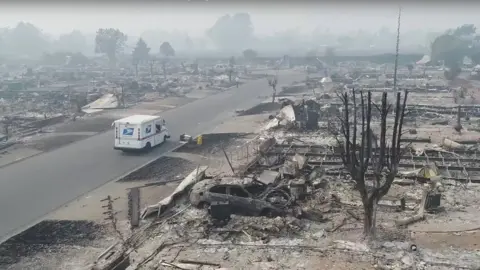Why can't California control the wildfires?
 Reuters
ReutersThe wildfires raging across northern California are already the most fatal in the state's history; at least 40 people are dead and thousands of homes have been razed.
Wildfires are a common occurrence in California towards the tail end of the state's long, hot, dry summers, but this year a combination of extremely high temperatures, strong winds, a long drought, and population growth have produced lethal, fast-moving blazes.
The fires are burning in one of the world's most developed countries though. Arrayed against the flames are more than 10,000 firefighters, 880 fire engines, 134 bulldozers, 14 helicopters, and more. So why is this blaze so difficult to control, and the death toll so high?
The wind
The late summer winds that blow into California from the Great Basin region, east of the state - the so-called "Diablo winds" - drop elevation as they move out towards sea level. That has a few knock-on effects. As the pressure increases at lower altitudes, the air gets warmer, the wind speed increases, and the humidity level drops.
That produces ideal conditions for a fast-moving wildfire. Northern California recorded gusting wind speeds of up to 70 mph this week, spreading the flames faster than firefighters could tackle them, and faster than some people could escape.
The high winds also overwhelm man-made and natural firebreaks, such as protection zones and wide highways, carrying embers across gaps in the brush that might otherwise contain the blaze. Hillsides compound the spread, as heat rises quickly up the steep terrain.
The heat and the drought
California has just experienced its hottest summer on record, with less than 25% average rainfall. The heat dries out vegetation, making it all the more combustible if a spark ignites in the wrong place.
The state is also still feeling the effects of a five-year drought that parched its forests, leaving tens of millions of dead trees in its wake - more fuel for the fire.
 Reuters
ReutersAnd counter-intuitively, California's extremely wet 2016-2017 winter may have also contributed to the spread of the blaze. The large amounts of vegetation that grew in the rain then dried out in the extremely hot summer that followed, providing even more fuel.
The homeowners
California's population is growing, and with it the number of homes built in high-risk fire areas. A 2014 study of residential growth in the state predicted that by 2050 there will be 645,000 homes built in "very high severity" zones.
Homes and other structures are increasingly being built adjacent to combustible areas of woodland. California law requires any structures in such a position to create 100 ft of "defensible space" - or firebreak - in every direction.
But the law is not aggressively enforced, it is left largely up to homeowners to police their own safety measures. And with a conflagration moving as fast as this one, in high winds, even a properly maintained firebreak might prove useless.
 Getty Images
Getty ImagesStory after story is emerging from California of people surrounded by fire in the middle of the night before they had a chance to escape, or of slight hesitations and delays that led to tragedy.
"This is what was so extraordinary about this event," Daniel Swain, a climate scientist at UCLA, told Inside Climate News. "Essentially it was a forest fire, a wildfire, that moved into an urban area. At some point it was jumping from house to house, not tree to tree."
Fighting the fire
Even in the world's most developed country, there is no high-tech solution to a wildfire of this size. Firefighters rely on relatively old-fashioned tactics to starve the massive conflagrations.
A fleet of planes and helicopters - including DC-10 airliners - is dumping water and fire-retardant on the blazes in an attempt to cool the air temperature and deprive the fires of oxygen.
 Reuters
ReutersFirefighters are also creating so-called containment lines, purposefully burning vegetation in the path of the blaze to deprive it of fuel. In recent years, a steep increase in the number of dead trees - from disease and drought - has made it too dangerous for fire crews to enter certain areas, as the trees are more susceptible to sudden collapse.
That means containment lines have to be created further back from the blaze itself, allowing more woodland to burn before the fire can be deprived of fuel.
One key way to save lives is to warn people early, but questions have been raised about the warning system in this case. Text alert warnings were issued last Saturday night, as the blaze began to spread, but only to those who had signed up to receive them.
The emergency "amber" alert system, which pings every phone in a region, was not activated by authorities. "There wasn't time to map out anything. There wasn't time to make a plan," Sergeant Spencer Crum of the Sonoma County Sheriff's Office, told the New York Times.
Beyond evacuation plans and firefighting tactics, California may need some help from above. A sustained, end-of-season rainfall would soak the vegetation and lower the air temperature. But it's a waiting game.
